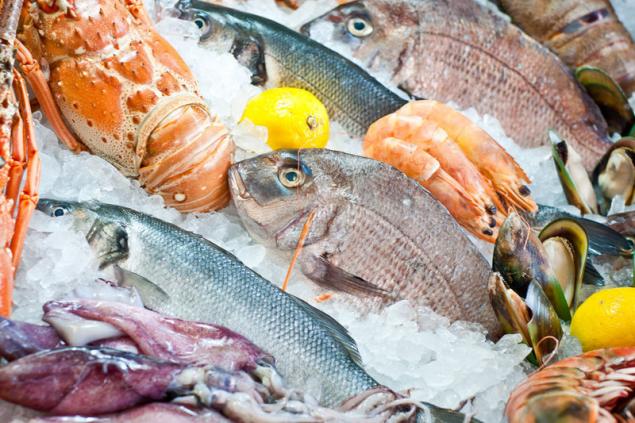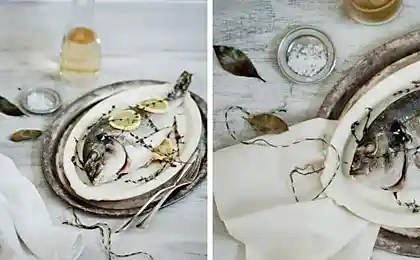647
How to store fresh fish
Fresh fish and seafood possess not only excellent taste but also great value for health. To make sure that the fish retained its original freshness after the catch, you have to be very careful when buying it. Despite the truth of the old German proverb: "the Oven is the best place for fresh fish" – there are cases when You need to store fish or seafood for several days before cooking.
Since the fish has an exquisite taste and very healthy, no wonder nutritionists recommend to use it for food at least once a week. Consider a few important rules on how to store fresh fish.

Pay attention to the freshness of the fish when buying. The fresher the fish You bought, the longer it will be stored.
So, how to understand, fresh fish or not? When you buy follow our tips below.
Storage of fish in large kolichestvah the fishing lovers there is a need to freeze large amounts of fish. Before freezing the fish should be fresh, it must be washed, clean and dry of any remaining water. Is that it was produced for later consumption as quickly as possible after the catch. If You caught the fish yourself, you need to cut it, and then pre-freeze on a tray without packaging, to avoid clumping. Subsequently, the fish or fillets can be placed in a thermal bag for compact storage and complete freeze.
It is also important to choose the correct and hermetically sealed. For this purpose, ideal for cooler bags and thermal bags. Optimal conditions for storage of fish are achieved in a vacuum pack. Packaged fish should have a label with the storage date, weight, type of fish and information about its mission.
Before you put the prepared fish in the freezer, you must activate the function "superzamorozki." This will allow you to quickly reduce the temperature in the freezer or low temperature bin, will create a reserve of cold, the temperature did not rise above the ceiling when placed in the camera a large amount of unfrozen food.
Please note that frozen fish should not be stored longer than 6 or 12 months (depending on fat content), because the fat in fish can deteriorate over time.
How to unfreeze reputational fish is best defrosted slowly in the refrigerator. If it will be used when cooking soup or stew, you can cook half thawed. The fish that will be prepared in the oven or in the pan should be completely thawed.published
P. S. And remember, only by changing their consumption — together we change the world! ©
Source: blog.liebherr.com/holodilniki/ru/kak-pravilno-hranit-svezhuju-rybu/
Since the fish has an exquisite taste and very healthy, no wonder nutritionists recommend to use it for food at least once a week. Consider a few important rules on how to store fresh fish.

Pay attention to the freshness of the fish when buying. The fresher the fish You bought, the longer it will be stored.
So, how to understand, fresh fish or not? When you buy follow our tips below.
- The fish should have a mild odor, in most cases – the scent of the sea or iodine. Stale fish has an unpleasant smell.
- Shiny, elastic scales – a sign of fresh fish.
- From fresh fish open, convex, translucent and bright eyes. Dim and grey eyes inherent in stale fish.
- The gills should be bright and shiny. Yellow and shades of brown characterize the unsold fish.
- If possible, will push the index finger on the scales of fish. Fresh fish will be firm and elastic, and the scales will not remain a trace after pressing. Flat fish should not lose shape when You take them in hand.
- Ideally, if the seller keeps the fish in a container with ice, not on ice, so it is better cooled.
Storage of fish in large kolichestvah the fishing lovers there is a need to freeze large amounts of fish. Before freezing the fish should be fresh, it must be washed, clean and dry of any remaining water. Is that it was produced for later consumption as quickly as possible after the catch. If You caught the fish yourself, you need to cut it, and then pre-freeze on a tray without packaging, to avoid clumping. Subsequently, the fish or fillets can be placed in a thermal bag for compact storage and complete freeze.
It is also important to choose the correct and hermetically sealed. For this purpose, ideal for cooler bags and thermal bags. Optimal conditions for storage of fish are achieved in a vacuum pack. Packaged fish should have a label with the storage date, weight, type of fish and information about its mission.
Before you put the prepared fish in the freezer, you must activate the function "superzamorozki." This will allow you to quickly reduce the temperature in the freezer or low temperature bin, will create a reserve of cold, the temperature did not rise above the ceiling when placed in the camera a large amount of unfrozen food.
Please note that frozen fish should not be stored longer than 6 or 12 months (depending on fat content), because the fat in fish can deteriorate over time.
How to unfreeze reputational fish is best defrosted slowly in the refrigerator. If it will be used when cooking soup or stew, you can cook half thawed. The fish that will be prepared in the oven or in the pan should be completely thawed.published
P. S. And remember, only by changing their consumption — together we change the world! ©
Source: blog.liebherr.com/holodilniki/ru/kak-pravilno-hranit-svezhuju-rybu/
9 stories of success born from failure
Corridors of power: 7 organizations that define world politics























